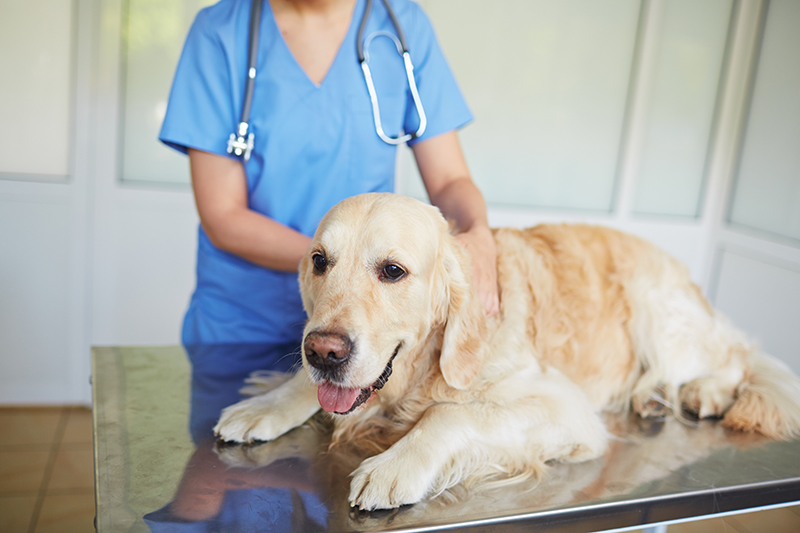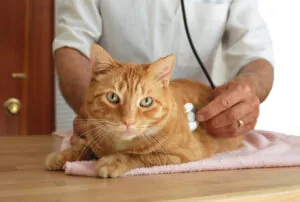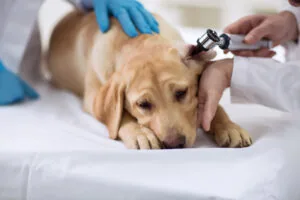Giardia

What Is Giardia?
Giardia is a single-celled microscopic parasite. It can live in the intestines of dogs (and other animals, including cats and humans) and cause severe gastrointestinal disease. Giardia can be an important cause of illness, especially diarrhea, in animals and people. However, the majority of dogs infected with Giardia do not have diarrhea, vomiting, or any other signs of illness.
The Giardia organism has two forms. A fragile feeding form, known as the trophozoite, exists in the gut of infected animals, while a hardy cystic form is shed in feces and can survive several months in the environment, particularly in water and damp environments.
Causes of Giardia in Dogs
Giardia cysts (outer shells that allow the parasite to live outside a host) must be ingested to cause infection. Pets are infected by eating food or drinking water that carries the cysts, or from ingesting infected feces directly.
Ingesting feces does not always mean eating poop from the ground. Ingestion can also happen when your dog sniffs other dogs’ hind ends (the most common greeting between dogs), then licks their nose. These cysts are immediately able to infect another animal. Giardia can be transmitted by eating or sniffing the cysts from contaminated ground, or by drinking contaminated water.
Can Humans Contract Giardia From Pets?
Your risk of contracting Giardia infection from your cat or dog is quite small. The type of Giardia parasite which infects humans is not the same one that infects mammals like cats and dogs. However, you must also note that some rodents and other mammalian species may harbor the type of Giardia that affects humans.
What are the signs of Giardia?
Animals that test positive for Giardia can range from having no symptoms to being critically ill, dehydrated and with profuse diarrhea. These microscopic parasites attach themselves to the intestinal wall and the damage causes an acute, sudden-onset of foul-smelling diarrhea. Giardia infection in dogs may lead to weight loss, chronic intermittent diarrhea, and fatty stool. The stool may range from soft to watery, often has a greenish tinge to it, and occasionally contains blood. Infected dogs tend to have excess mucus in the feces. Vomiting may occur in some cases.
Cats and dogs with Giardia can be asymptomatic, meaning that they show no signs even though they have an infection. This means the parasite can still be doing damage to their digestive tract, and they can still be shedding the parasite and act as a source of infection for other pets.
How is Giardia diagnosed and treated?
A microscopic examination of fecal matter will typically demonstrate Giardia cysts. Cell proteins of Giardia can also be tested for in the blood or feces via ELISA. Giardia cysts are very small and can be difficult to visualize; submission of specimens to a reference laboratory is often the most reliable testing method. Giardia cysts can be shed intermittently. If diarrhea persists in a patient retesting for Giardia via ELISA of fecal may be recommended.
Your veterinarian will prescribe the most appropriate treatment(s) for your cat or dog if they’re having diarrhea and are diagnosed with Giardia. There are a few different medications they may choose from. Sometimes one will work better than the others, and occasionally multiple medications may be needed, either at the same time or successively. Occasionally, more than one round of treatment will be necessary if your pet still has diarrhea and follow-up testing confirms the continued presence of Giardia.
Medication isn’t the only important aspect of successful treatment for Giardia in cats and dogs. Here are other things you should be aware of and do when you have a pet (or pets) with Giardia:
- For dogs: Pick up their poop promptly after they go to the bathroom on walks, or at least daily in your yard if you let them out to do their business without you.
- For cats: Scoop their litter boxes daily (at least) and do a complete litter change and box wash after their last day of treatment.
- Keep them separate from any other pets in your home, or at least have them defecate in a different litter box or area of the yard away from your other pets.
- Don’t take your dog swimming or to the dog park (or any public park or school).
- Give a bath on the last day of treatment. This can be an important step to remove any infective Giardia cysts that may have gotten onto your pet’s fur while they were infected and having diarrhea.
- Remove standing water (for example, empty any containers of water and remove any water from fountains that are not in use).
- Do not allow any new animals, especially young ones, to enter the yard or other outdoor space until advised by your veterinarian.
- Clean and disinfect potentially contaminated items (for example, toys, water bowls and food bowls, pet bedding, floors, dog crates, linens, towels, litter box) regularly for as long as your pet is sick.
- If your pet is taking medication, clean and disinfect potentially contaminated items frequently (daily if possible) until a few days after the last dose of medication is given.
- Limit your dog’s access to creeks, ponds, lakes, and other water bodies to avoid re-infecting your animal and contaminating the water, which could make other animals sick.
How long does it take for Giardia to go away?
Giardia will last until it is treated and removed from the environment, with multiple negative tests confirming the disease’s resolution. The indoor and outdoor spaces that your pet(s)uses must also be decontaminated, or your pets may become reinfected. It typically takes at least a couple weeks of treatment and strict environmental management to clear the disease.
Share This Post
Recent Posts
About Shallowford Animal Hospital
Shallowford Animal Hospital and The Pet Spa at Shallowford are dedicated to the exceptional, compassionate care your pet deserves. Pets hold a very special place in our families, and we treat yours like our own.



